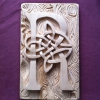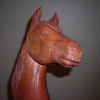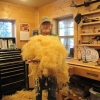Wood changes shape as it dries, and it's important for carvers to be able to 'read' their material so as to allow for this. In particular, this understanding of shrinking and warping is needed in relief carving and glueing up of boards and blocks.

| 07 March 2016 21:54
Azucena - Yes, it can get quite complicated! You do want to pay attention to how the wood will move, try to get your block so that no part is fighting against another, but at the the end of the day you can only do the best you can. In a compound block, you'd want to get each layer stable by working edge to edge. You might then have to re-plane before stacking the layers face to face block as you want tight joints. Stagger the joins in successive layers and make sure you have plenty of pressure (and squeeze out) from the clamping. Hope this helps!

| 05 March 2016 16:11
Chris - If I want to carve something in the round and need to glue multiple boards together in order to form a block (stacked on top of each other and also side by side), do I need to be concerned about the orientation of the rings? Thanks for all the informative videos!

| 09 February 2013 19:53
Steve - The thing is, once you carve into a board 'downhill' can easily become more relative tot he form than the board. I always prefer heartwood if I can use it; the fibres are often tighter and carve better than the sapwood. I never actually 'dig into the growth rings', as you put it. I wonder if that's because you are removing waste along the grain? If you look throughout the projects you'll see I do all my roughing out ACROSS the grain, so 'uphill' or 'downhill' doesn't apply. Then when I'm modelling, it's the form which dominates rather than the grain. I hope this makes sense!

| 27 January 2013 22:47
Chris - When relief carving, I thought it was better to carve on the sapwood side of a flat-sawn board so that much of the carving would be downhill, with the growth rings, rather than into the growth rings. As you point out, flat-sawn boards tend to cup toward the sapwood side and once wood is relieved from the sapwood side, the cupping becomes even more pronounced. Do you have significant problems relief carving on the heartwood side of the board since it seems like you will be more likely to dig into the growth rings than on the sapwood side? Your instructions are making me rethink my approach to this issue - which is good. Thanks.

| 13 July 2012 17:23
Robert - I don't think 3mm would have made a lot of difference, so I'd go for the fact that it was released from the board. The pressures within wood are often unpredictable. ( I've seen a beautiful straight plank divided lengthwise into 2 banana-like pieces...). It might be that the surface is drying out because the back has been clamped to your bench and thus cannot lose moisture like the front? - stand your carving up between sessions. Best advice is to just complete your carving; let the piece adjust to its final shape and plane off the back to flat. Then check the front and the carving so it also looks flat. And then seal/finish. Should look fine!

| 13 July 2012 01:53
Hi Chris -- I am brand new to wood carving. Gee, I wish I'd seen this video before I started on the "Mind like Water" setting in project from one of your books. A fine piece of Fijian Mahogany and a soon as I started grounding in after outlining with my V tool, the wood began to warp just as you've demonstrated.
Tell me, Chris, the piece was cut from a long board (about 2.3 m) -- would the warping have started immediately I cut the working piece from the length, or only after I began exposing the 'fresh' wood by carving away a good 3 mm of the thickness for the background? (ps, I am loving this site and your presentation of the lessons)

| 16 November 2011 15:42
Peter - yes. Quarter-sawn is always going to be the most stable timber, though not always easy to get hold of.

| 16 November 2011 13:01
Would it make sense to use the quarter sawn sections of the log to do relief or sign carving to help maintain the flat shape of the board?

| 27 August 2011 12:18
Robert - If you seal ('finish') the front of your carving, you must seal the back as well. Otherwise one side is open the the atmosphere, and can absorb or give up moisture - thus shrinking or swelling, and the other isn't. This is assuming your wood has 'seasoned' - reached ambient moisture - before carving. If it isn't, if the wood is still 'green', then sealing will slow down whatever changes might occur, but not really alter the outcome, which is inherent in the structure of the wood itself..

| 20 April 2011 05:04
They CAN be framed or mounted this way, though the effect of a frame is often included in stand-alone relief carvings.
The real trick is to learn to work with your wood in such a way that you pre-empt problems of warping or splitting - though wood being wood, it's not always as predictable as we'd like!

| 16 April 2011 12:50
Are relief carvings mounted "freely" to move on a background piece, similar to a panel in a door so that the curvature of the piece does not split (i.e. not glue it flat to a background piece?)